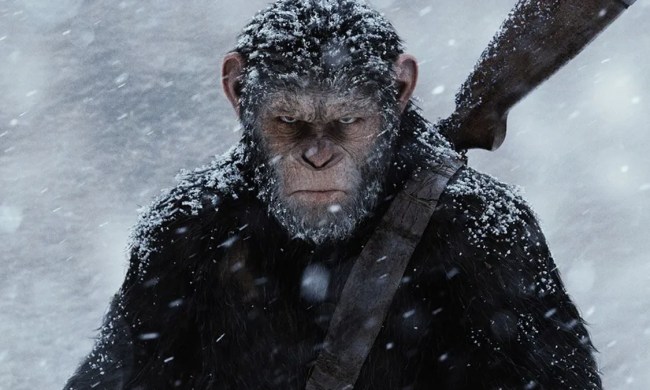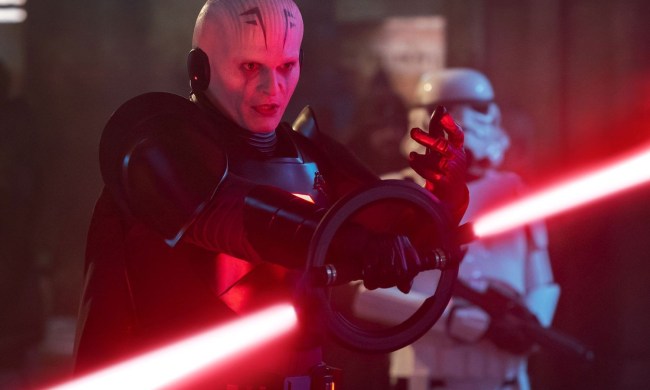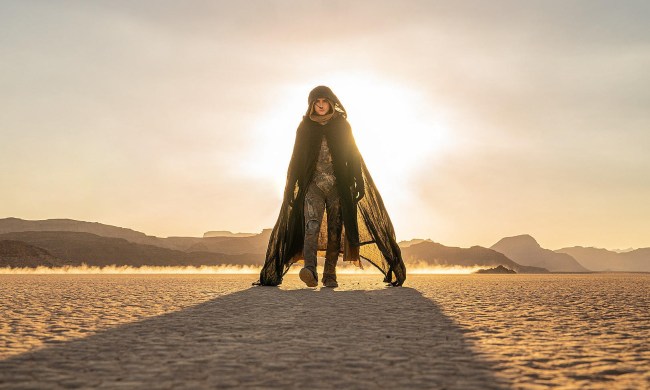
As much as fans love to praise Star Trek as groundbreaking science fiction, it’s important to remember that, for most of the franchise’s history, Trek was weekly procedural television. Until the streaming era, each series was churning out roughly 26 episodes a year, and by the later seasons of Star Trek: Voyager, some of the creative crew had been in the business of making Star Trek for over a decade. The franchise was a crossover commercial success, the kind of success that the money men like to leave exactly as it is for as long as it’s doing steady numbers.
The operation was essentially on rails, and there was a lot of pressure from the studio and the network to keep it that way, which accounts for the general blandness of Voyager and the early years of its successor, Enterprise. The waning years of Trek’s golden era were plagued by creative exhaustion and, consequently, laziness. Concepts from previous series were revisited, often with diminishing returns, and potentially groundbreaking ideas were nixed from on high in order to avoid upsetting the apple cart.
That’s not to say that Star Trek: Voyager isn’t still a solid television show, and even many Trekkies’ favorite. The saga of Captain Kathryn Janeway (Kate Mulgrew) and her gallant crew finding their way home from the farthest reaches of the galaxy may not be as ambitious as it could have been, but it is steadily entertaining, which is why new and nostalgic fans alike enjoy it as cozy “comfort viewing.” For our part, however, we tend to enjoy the episodes that have a certain emotional intensity or creative spark, that feel like conceptual or stylistic risks. As such, you might find that our list of the 10 best Voyager episodes differs greatly from some of the others out there. We like when Voyager dared to get heavy, or silly, or sappy, or mean. So, without further ado, let’s raise a glass to the journey …
Like Star Trek? Then check out how do I get into Star Trek?
10. Counterpoint (season 5, episode 10)

Counterpoint drops the audience into the middle of an ongoing story,in which Voyager is boarded and inspected by agents of a fascist government, the Devore. The Devore treat all travelers through their space with suspicion, but are particularly concerned with capturing and detaining all telepaths, who they view as dangerous. Despite the risks, Captain Janeway is attempting to smuggle a group of telepathic refugees to safety, all while putting on a show of cooperation for smiling Devore Inspector Kashyk (Mark Harelik). Much of the plot takes place in the background, obscured from the audience in order to build suspense. The real focus is on the evolving dynamic between Janeway and Kashyk, a rivalry that simmers into one of the Voyager captain’s rare romances. Kashyk works in the service of what are, transparently, space Nazis, but when he offers to defect to Voyager, can his intentions be trusted?
Beyond its intriguing premise, Counterpoint is a particularly strong production with a lot of subtle hints of creative flair. Director Les Landau and director of photography Marvin Rush, who had been both working on Star Trek since the 1980s, shoot the hell out of this story, breaking from Voyager’s even lighting and predictable camera moves to make some very deliberate choices that build a great deal of tension around what is essentially a bottle episode. The makeup team, supervised by equally seasoned Trek veteran Michael Westmore, supplies a memorable and imaginative makeup design for an alien astrophysicist who appears in all of two scenes in this episode and is never utilized again. Most of all, Kate Mulgrew provides what may be her most subtle, human performance in the entire series, embodying Janeway’s famous conviction and strength of will while also granting a rare glimpse at her more vulnerable side without ever straying into melodrama.
9. The Thaw (season 2, episode 23)
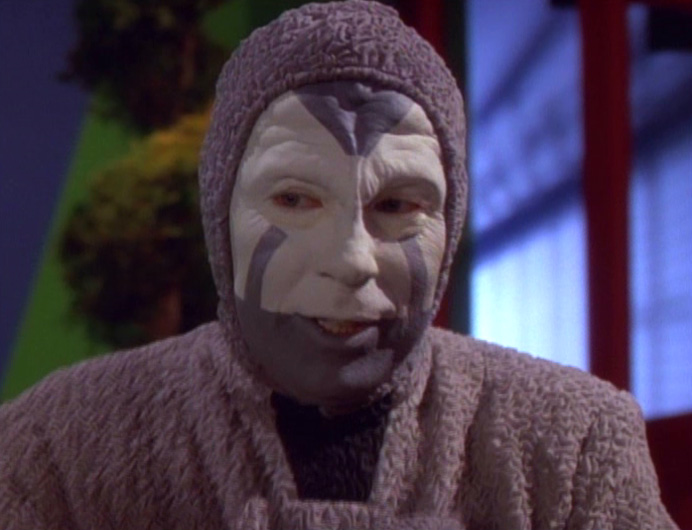
If you look back at Star Trek: The Original Series, in-between the deep dramas and camp classics, you’ll find a lot of episodes that are just plain weird. The same is true for the best Star Trek spinoffs, and there’s no Voyager story as boldly off-putting as The Thaw, which guest stars This is Spinal Tap and Better Call Saul’s Michael McKean as a maniacal AI who literally scares people to death. In this episode, Voyager comes across a group of aliens who have been trapped in suspended animation ever since an environmental disaster struck their planet two decades earlier. To pass the time while in hibernation, the survivors have hooked their brains up to a virtual reality, where they are supposed to be entertained by a wacky character known only as “the Clown.”
Unfortunately, what the Clown finds most entertaining is probing their minds for their innermost fears and turning it into weird performance art, and he refuses to let his audience leave. When the Voyager crew attempts to rescue them, the Clown takes Ensign Harry Kim (Garrett Wang) hostage and proceeds to menace him for most of the episode. And, folks, it’s a trip.
The Thaw is a colorful, not entirely comprehensible, totally unclassifiable episode. It’s sort of horror, it’s sort of comedy, it’s sort of character study, but mostly it’s just entertaining. And for however much of it is up to interpretation, it’s a rare glimpse at the psyche of Harry Kim, one of Voyager’s least explored characters. Above all, however, it’s a delight to watch McKean perform what’s essentially his take on the Joker, a homicidal clown with a genius intellect and a poetic flair. Mulgrew, consequently, gets to play Batman, facing down his gleeful menace with stillness and determination. It’s one of the few real treats from the early seasons of the series, one whose reputation among fans has only grown since its premiere in 1996.
8. Mortal Coil (season 4, episode 12)

Aside from maybe The Next Generation’s Wesley Crusher, no Star Trek character was as immediately reviled as Voyager’s chef, ambassador, and morale officer Neelix (Ethan Phillips). On most episodes of Voyager, Neelix is the goofy comic relief, performing folksy, unfunny antics around the mess hall or annoying the stoic Vulcan Lt. Tuvok (Tim Russ) with his naivety and effervescence. His unsettling long-term romantic relationship with Kes, who is technically a two-year-old when the series begins, is also part of Trek’s most irritating love triangle.
And yet, when Neelix is the center of an episode, it often reveals him to be one of the show’s most textured and interesting characters. Neelix is a survivor of a devastating war that destroyed his home and claimed the lives of his entire family. Beneath the persona of a “happy wanderer” resides a deep sea of melancholy and a predisposition towards depression. It’s a performance for his own benefit, as well as for the weary Voyager crew, and if it seems like he’s trying too hard, that’s because he is.
In the episode Mortal Coil, Neelix is killed on an away mission, only to be resuscitated 18 hours later by Seven of Nine (Jeri Ryan) and her advanced Borg medicine. The crew is happy to have him back, but the experience rocks Neelix to his core. Neelix has always believed that he would be reunited with his family in the afterlife, but upon his death, he experienced no such thing. Neelix’s crisis of faith provides Phillips an opportunity to really dig his teeth into his character, and to take a heavy, nuanced look at belief, mortality, depression, and suicidal ideation.
Writer Bryan Fuller, who would go on to create NBC’s Hannibal, puts his psychological horror chops to great use here, and director Allan Kroeker sustains a feeling of dread that places the audience on edge and off-balance. The story resolves itself a little too quickly and is never mentioned again, but that’s par for the course on Voyager. But when evaluated on its own, Mortal Coil holds up against some of Trek’s best character studies.
7. Latent Image (season 5, episode 11)

Following up on the popularity of Data on The Next Generation, Voyager debuted with its own artificial crewmember, the Emergency Medical Hologram (Robert Picardo), usually just called “the Doctor.” Rather than a supposedly emotionless android, the Doctor is a hologram based on the grouchy engineer who designed him and endowed with the medical knowledge of the entire Federation. At the start of the series, everyone — including the Doctor himself — considers him to be a tool intended for short-term use, rather than a person, but since he’s left online for years rather than hours, he gradually develops his own personality and preferences, becoming a sentient individual.
Unlike in Data’s case, however, it takes the crew a long time to get used to the idea of the Doctor being his own man, and they continue to infringe on his rights, his privacy, and his very programming for much of the series. Sometimes the Doctor’s indignity is played for laughs, sometimes for sympathy, and in our next episode, for horror.
In Latent Image, the Doctor discovers evidence that he performed a delicate neurosurgery on Ensign Kim 18 months earlier, but he has no memory of the event, and neither does the rest of the crew. With the help of Seven of Nine, who joined the cast in the intervening year, the Doctor attempts to unravel the mystery of what really happened, leading to a terrible discovery that calls his relationship with Capt. Janeway and the rest of the crew into question. We won’t give away the answer here, but the story digs deep into the complexity of the Doctor’s character and his nature as an ascended artificial intelligence, and offers Picardo his meatiest acting challenge. You won’t find it on a lot of Best of Voyager lists, but it remains one of the show’s greatest hidden treasures.
6. Bride of Chaotica! (season 5, episode 12)
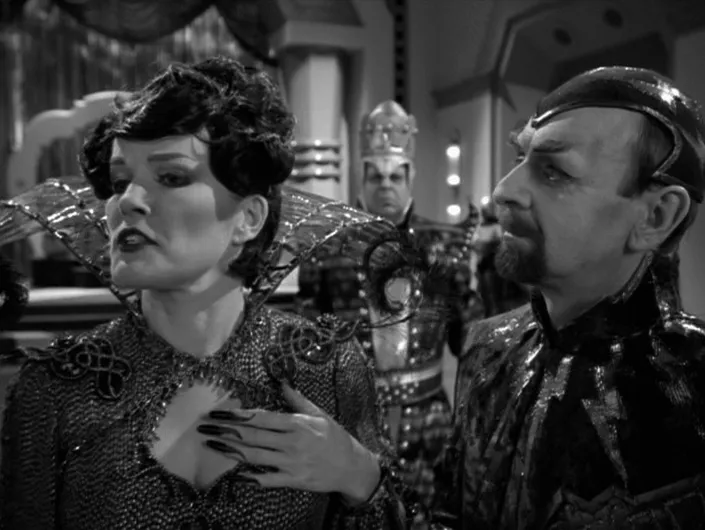
Lest we leave you with the impression that the best of Voyager is all gloom and doom, our next entry is one of the lightest and funniest episodes of the series. Despite being set aboard a Starfleet vessel blasted to the far side of the galaxy with limited resources and no support, Voyager assures the audience early on that the ship’s holodecks are still fully functional, allowing the crew to go on their LARPing (live-action role-playing) adventures just like on The Next Generation. Most of the crew’s fantasies proved to be pretty forgettable, until the introduction of Tom Paris’ (Robert Duncan McNeill) new favorite holonovel, The Adventures of Captain Proton. Modeled after the classic Flash Gordon film serials — right down to the cheap effects and black-and-white photography — Captain Proton became a recurring treat during Voyager’s fifth season, and is at the center of the No. 6 pick on our list, Bride of Chaotica!
In this episode, Tom and Harry’s latest excursion into the monochrome world of Captain Proton attracts the attention of photonic beings from another dimension, to whom the fictional villain Doctor Chaotica (Martin Rayner) is terrifyingly real. War breaks out between the photonic sentients and the 1930s-style bad guys, and the only way to save the day is for the crew to play along with the campy program. And because no Star Trek series is complete without the captain getting into a silly outfit and hamming it up, Janeway must pose as Chaotica’s evil bride, the devilish Arachnia! Mulgrew and the rest of the cast are plainly having a ball with this episode, and the fun is contagious. Keeping the holodeck around for the run of Voyager may have been one of the signs that the series was going to play things relatively safe, but it did give us one of the franchise’s best holodeck episodes.
5. Living Witness (season 4, episode 23)
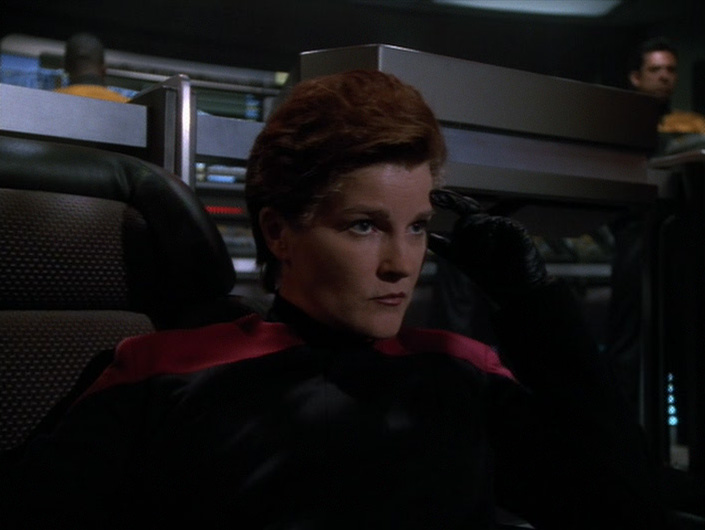
History is written by the victors, and subject to countless revisions over the passing centuries. How much of what we think of as historical fact is actually widely accepted conjecture or outright fabrication? We’ll probably never know, unless some eyewitness from the distant past turns up in our present to set things straight. This, naturally, is exactly what happens in Living Witness, as a backup copy of the Doctor is reactivated on an alien planet 700 years after Voyager participates in a pivotal political conflict.
For the Kyrians, it’s a well-known fact that the Warship Voyager eagerly aided their aggressive neighbors, the Vaskans, in unleashing a weapon of mass destruction against their homeworld. Captain Janeway is a cutthroat who will stop at nothing to get her crew home, Seven of Nine habitually assimilates her enemies and maintains her own small Borg collective onboard, and the Doctor is an android. When the holographic Doctor is awakened, he is aghast at the way his friends have been mischaracterized and sets out to prove what really happened, or else be punished for the genocide they’re accused of committing.
The Voyager cast never got the chance to play in the famous Star Trek Mirror Universe, home to the over-the-top evil versions of our Starfleet heroes, but Living Witness offers Mulgrew, Robert Beltran (Commander Chakotay), and company the opportunity to go full cartoon baddie, all in the name of poignant satire. It’s a bizarre comedy episode with an uncomfortable, but undeniable lesson: Time flattens everything. From a distance, every person, group, or thing becomes either all good or all bad, and that evaluation changes depending on who’s looking, and from where. In order to preserve the nuance of truth, we have to be willing to treat history as a process rather than a product, or else lose all sense of reality.
4. Prime Factors (season 1, episode 10)

For fans who hoped that Voyager would lean into its intriguing premise of a motley crew of officers and terrorists having to rough it in the wilderness of space, much of the series turned out to be a real letdown. Almost immediately, the tension between the upstanding Starfleet and scrappy Maquis crewmembers, and the added tension of having to scrape and forage to survive, began to dissolve until Voyager was more or less the same familiar Trek that fans had been getting for the previous seven years. However, early on, there are a few episodes that truly capitalize on the show’s potential. The best example of this is Prime Factors, which introduces a dilemma that divides the crew between those who hold Starfleet’s principles as sacrosanct and those who didn’t sign up for this and just want to go home.
The setup is a terrific reversal of a classic Star Trek problem. A group needs help, but helping them means violating the Prime Directive, which forbids interfering in the internal affairs of other cultures. The twist? This time, our heroes aren’t the technologically advanced institution debating the virtues of foreign intervention, they’re the party in need. The friendly, benevolent Sikarians have the technology to send Voyager home instantly, but their own Prime Directive dictates that they not share it. How do Janeway and company feel when the shoe is on the other foot? How will a divided crew take the news, and will they all be inclined to abide by the Sikarians’ ruling?
It’s a fascinating study of ethics, ethical relativism, and the smugness often projected by even the most well-meaning of privileged do-gooders. How many planets have been a Federation ship’s “problem of the week” to be solved (or not solved) and then forgotten? In Prime Factors, our Starfleet stalwarts experience what it’s like to become someone’s pet cause, and learn that the charity of the privileged and comfortable only lasts as long as it’s convenient and self-gratifying.
3. Year of Hell, Parts I & II (season 4, episodes 8 & 9)

If Prime Factors exemplifies the potential of Voyager’s beginnings, Year of Hell is a glimpse of what the show could have become if it had stayed the course. In this episode, which was initially envisioned as a season-long arc, Voyager’s long journey home takes them through the Krenim Imperium, whose brutal militaristic regime treats them as invaders and repeatedly kicks the crap out of them for 12 long months. The situation aboard Voyager gets increasingly dire as the crew takes casualties and the ship falls into disrepair. Hard choices have to be made about how to survive, and whether or not their goal of reaching Earth is even attainable. Janeway and company are pushed to their limits and left with permanent physical and psychological scars.
Or, they would be, if this wasn’t also a time travel story. The thrill of Year of Hell is undercut somewhat by being a “What If?” story whose events are erased from the timeline before the credits roll on Part II, but the actual time travel mechanics of the episode are fun and interesting. From the outset, the audience knows that the timeline of the story is in flux, as the power-mad Krenim scientist Annorax (Kurtwood Smith) selectively erases entire civilizations from time in order to restore his planet’s empire to full strength and rewrite his wife’s untimely death.
However, the characters don’t learn this until nearly nearly a third of the way through the story, after we’ve already seen their circumstances suddenly change a few times. Year of Hell becomes a story about causality, about the reverberations of the smallest actions upon the grand tapestry of history, and the futility of trying to curate one’s own fate. It’s a terrific two-hour epic, and even if we’d rather have seen it play out over the course of an entire year, we wouldn’t dare try to go back and change it.
2. Blink of an Eye (season 6, episode 12)

If Voyager isn’t going to be about a struggle for survival in the wilderness of space, then it damn well ought to be about exploring its wonders. Blink of an Eye is the kind of episode that could easily fit into any Star Trek series (or a non-Trek one, as its premise is suspiciously similar to the 1980 Robert L. Forward novel Dragon’s Egg). Here, Voyager becomes trapped in the orbit of a planet with a strange property — for every 1.03 second that occurs in normal space, a year passes below. As the civilization on the planet evolves over centuries from a pre-industrial society to a futuristic one, the starship Voyager remains a fixture in their sky, inspiring religion, folklore, and a cultural obsession with reaching the stars.
The story cuts back and forth between the Voyager crew’s attempts to escape the planet’s orbit and generations of scientists and philosophers as their understanding of their celestial visitor evolves. Where some Trek episodes such as A Piece of the Action or Who Watches the Watchers frame accidental interference into an alien culture as a irreversible calamity, Blink of an Eye takes a more subtle approach, showing the often inspiring ways that a civilization grapples with the great mysteries of life.
The highlight of the episode is guest star Daniel Dae Kim (pre-Lost) as one of the first astronauts from the planet to set foot aboard Voyager. Through his eyes, we get to experience the joy and overwhelming emotional power of discovery, the very thing that inspires our Starfleet heroes to explore space in the first place. Star Trek is, ultimately, a show about curiosity, about humanity’s irrepressible drive to learn and understand our universe. There are few episodes in the entire Star Trek canon that capture this feeling more perfectly than Blink of an Eye. It’s the kind of story that, though simple and relatively low-stakes, should tug on the heartstrings of anyone who has sought inner peace through knowledge and appreciation of their outside world.
1. Timeless (season 5, episode 6)
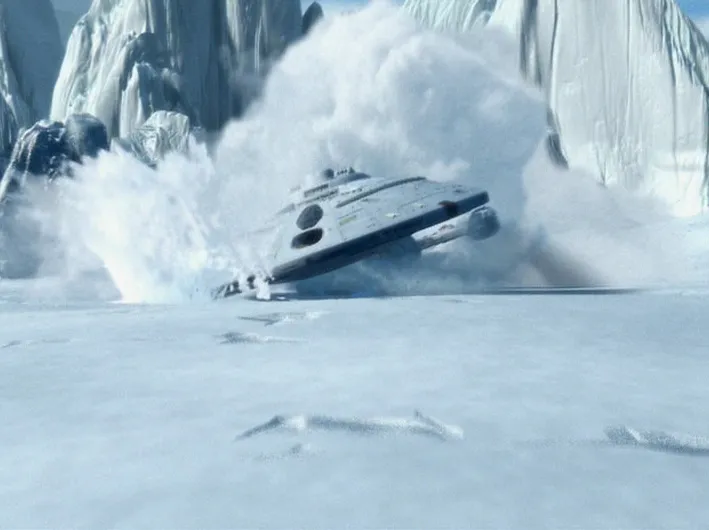
For Voyager’s 100th episode, producers Rick Berman, Brannon Braga, and Joe Menosky decided to crash the ship into a planet and kill off almost the entire cast. We’re kidding! Well, sort of. Timeless follows future versions of Chakotay and Harry Kim, the only survivors of Voyager, which was destroyed during a test of a new form of propulsion. This new technology brought Chakotay and Kim’s shuttle all the way home, but the rest of the crew was condemned to an icy grave. Racked with guilt over his role in their deaths, Kim becomes obsessed with going back in time to undo the disaster.
The story is told across two time frames, splitting between the present of the show and a future in which Kim and Chakotay’s quest to fix their mistake has made them outlaws. It’s a thrilling time travel episode that puts the focus on the show’s most neglected regular characters. Chakotay gets to be roguish again, a quality he’d long since shed along with the rest of his personality. For his part, Wang actually gets to show some range, playing a brooding, self-loathing wreck with nothing left to lose.
Even though it’s a foregone conclusion that the time travel mission will succeed and none of this story will have happened, Timeless truly feels like an event. It’s emotional, it’s visually striking, and occasionally very funny. (Seven of Nine’s first experience with alcohol ranks among the most quotable and memetic scenes in the series.) It’s only an hour long, but it plays like a movie. The stakes are high, the scope is vast, the characters are rich, and there’s even a cute cameo from Next Generation star LeVar Burton, who also directed the episode.
Voyager is often feather-light, and occasionally, as the rest of this list demonstrates, super heavy. Timeless perfectly captures the balance of intensity and fun of a great “Star Trek” feature, akin to Star Trek II: The Wrath of Khan or Star Trek: First Contact. It probably shouldn’t be anyone’s first Voyager, but when we’re in the mood to check out just one of the show’s episodes, this is the one we reach for.
For more Star Trek content, please check out the best Star Trek: The Original Series episodes, the best Star Trek: The Next Generation episodes, and the best Star Trek: Deep Space Nine episodes.

